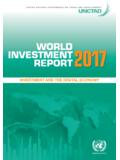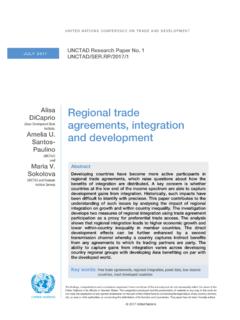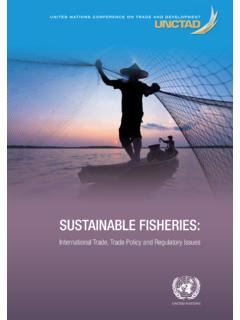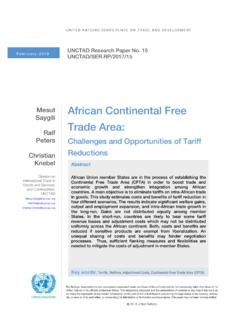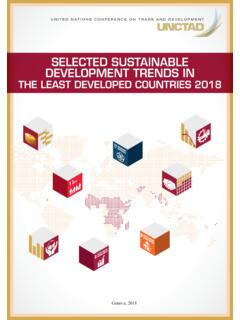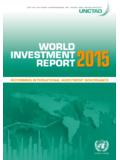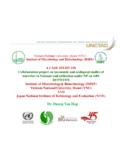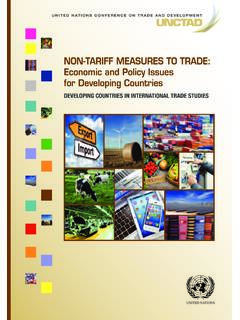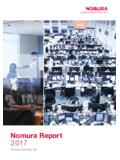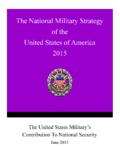Transcription of The Asian Economic Integration Cooperation …
1 AUGUST 2017 UNCTAD Research Paper No. 3 Amelia U. Santos-Paulino Division for Africa, Least Developed Countries and Special Programmes, UNCTAD The Asian Economic Integration Cooperation Agreement: lessons for Economic and social development Abstract This paper examines the impact of regional Integration on development in the ASEAN Economic community. The study presents a measure of bilateral trade balances showing that despite rapid trade expansion, imports have grown faster than exports resulting in a deterioration of the trade balances in Cambodia, Laos, Myanmar and Vietnam - the less developed members of the agreement.
2 The analysis also throws light on ASEAN's emphasis on promoting equitable Economic development between its members. The study argues that trade agreements should seek to promote coherence between country-level and regional strategies to achieve the complex and multifaceted development objectives beyond trade Integration . Key words: ASEAN, development gap, regional Cooperation , regional Integration , LDCs 2 UNCTAD Research Paper No. 3 _____ _____ Contents Acknowledgements .. 2 1. Introduction .. 3 2. Regional Integration in ASEAN: progress, prospects and challenges .. 4 3. Deeper Integration and inclusive development in the ASEAN Economic Community .. 11 4. Conclusion and policy implications.
3 13 Appendix .. 15 References .. 25 Acknowledgements The author is grateful to seminar participants at Fudan University, Shanghai, and to Patrick Osakwe, Maria Sokolova and an anonymous referee for comments and suggestions. Berna Dogan and Agnes Collardeau-Angleys provided helpful assistance. 3 UNCTAD Research Paper No. 3 _____ _____ 1. Introduction Global trade Integration has proceeded at a fast pace since the founding of the GATT/WTO and numerous trade agreements have been signed under the institution s provisions. Regional trade agreements started to proliferate from the 1980s, and in the 1990s regionalism re-emerged as a major driver of trade liberalization and Integration both in developed and developing regions.
4 Important agreements came into force across developing countries including ASEAN, MERCOSUR, NAFTA, COMESA, and CACM. The trend, as well as GDP growth in developing countries, is depicted in figure 1 and developing Asia stands out. Even if around 267 RTAs have been notified to the WTO (WTO, 2016) in reality more than 8,000 bilateral trade relationship pairs within RTAs are currently in place, and one-third of such relationships correspond to Asian agreements. The rising wave of free trade agreements as a trade policy instrument has led to the transformation of Asia from one of the poorest globally to Factory Asia (Baldwin, 2011). Despite rapid liberalization, whether bilateral or regional, pinning down how regional Integration addresses member countries' development concerns is challenging.
5 The paper focuses on the Integration process between countries in It discusses the main achievements resulting from the ASEAN agreement, particularly in terms of growth, trade and investment. In addition to solid Economic growth, rapid trade and investment expansion made possible by regional liberalization, ASEAN members have made other important inroads in terms of structural change as compared to other developing regions. This includes higher rates of productivity in tradable goods, and the shift from primary products towards manufacturing and services. Source: Author's elaboration based on data from DiCaprio, Santos-Paulino and Sokolova (2017) and World Bank (WDI, 2016).
6 Note: RTA pairs (World and Asia) in the left axis (in thousands); total trade flows and GDP growth (right axis, in %). 1 The ASEAN Community is comprised by the so-called ASEAN 6: Indonesia, Malaysia, the Philippines, Singapore and Thailand (the original members that joined on 8th August 1967), and Brunei Darussalam (7 January 1984); and the ASEAN-4 group: Viet Nam (28 July 1995), Lao PDR and Myanmar (23 July 1997), and Cambodia (30 April 1999). Figure 1. Development of Regional Trade Relationships, Total Trade and GDP in the World 4 UNCTAD Research Paper No. 3 _____ _____ The paper also discusses challenges concerning the development gap - measured by various socioeconomic indicators - between ASEAN members, which range from LDCs to high income economies.
7 Traditionally, the implications of RTAs have been assessed focusing on market access issues while sidelining broader development implications. Yet regional Integration could serve as an instrument for development by increasing trade, investment and employment. In addition to these traditional channels, regional Integration can also impact poverty by encompassing regional socio- Economic projects providing infrastructure and regional public goods. Thus, the type and scope of the regional Integration process may be relevant for poverty The ASEAN Free Trade Agreement expressly emphasizes the development dimension of trade Integration by addressing the inequalities amongst its members.
8 In this context, the paper evaluates the pillars of regional Integration that could impact development, and the eventual convergence of the members' development gap, including poverty reduction and trade diversification. In this setting, domestic policies to compensate for possible negative shocks of Integration are crucial (Gallagher et al, 2015). Despite the manifest gains regionalization also brings about costs. The well-known puzzle of overlapping RTAs described by Bhagwati (1991) as spaghetti bowl , and subsequently Baldwin's (2004) noodle bowl , referring to the proliferation of trade agreements in Asia may adversely affect the welfare-enhancing potential of regional agreements.
9 A key challenge is harmonizing the array of barriers related to international production networks prevailing in Asia, given the high interdependence of manufacturing exporters in intra-regional trade (Baldwin, 2015). Also, addressing the diverse priorities, institutional capabilities and policies of member countries in a cumbersome net of agreements is a matter of concern. The paper proceeds as follows. Section 2 discusses ASEAN s socioeconomic progress. Section 3 looks at the role of regional Integration in addressing the development gap in ASEAN. Section 4 concludes and discusses policy implications. 2. Regional Integration in ASEAN: progress, prospects and challenges Research measuring the impact of regional Integration in Asia has conventionally focused on the effect on trade flows.
10 Some case studies address development matters, mostly the impacts on inequality and welfare. Overall, the benefits and challenges of trade Integration have been addressed through various angles and techniques, highlighting both the gains and the complexities that might arise from the multiplicity of agreements. Wha-Lee and Shin (2006) show that the East Asian RTAs, which are considered natural trading partners because of proximity and other characteristics, are likely to create more trade among members without diverting trade from non-members. Despite the magnitude of intra-regional agreements, a number of existing and proposed RTAs also include groupings with significantly distant The current efforts toward regionalism are intended to build non-discriminatory blocs, which may eventually lead to a more integrated world economy, including the elimination of non-tariff barriers (NTBs) which is one of the pending issues in ASEAN liberalization agenda (Li and Whalley, 2014).
